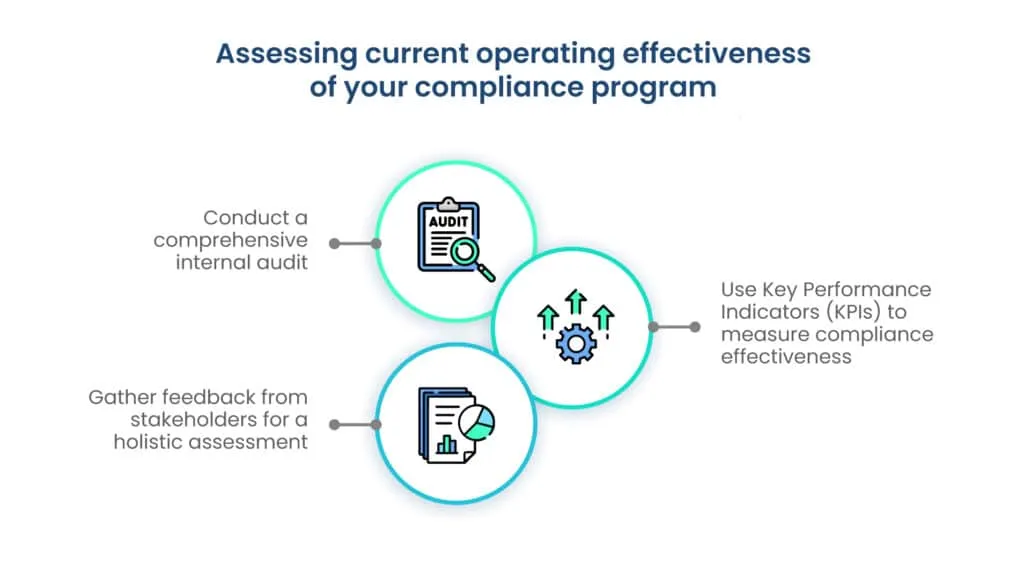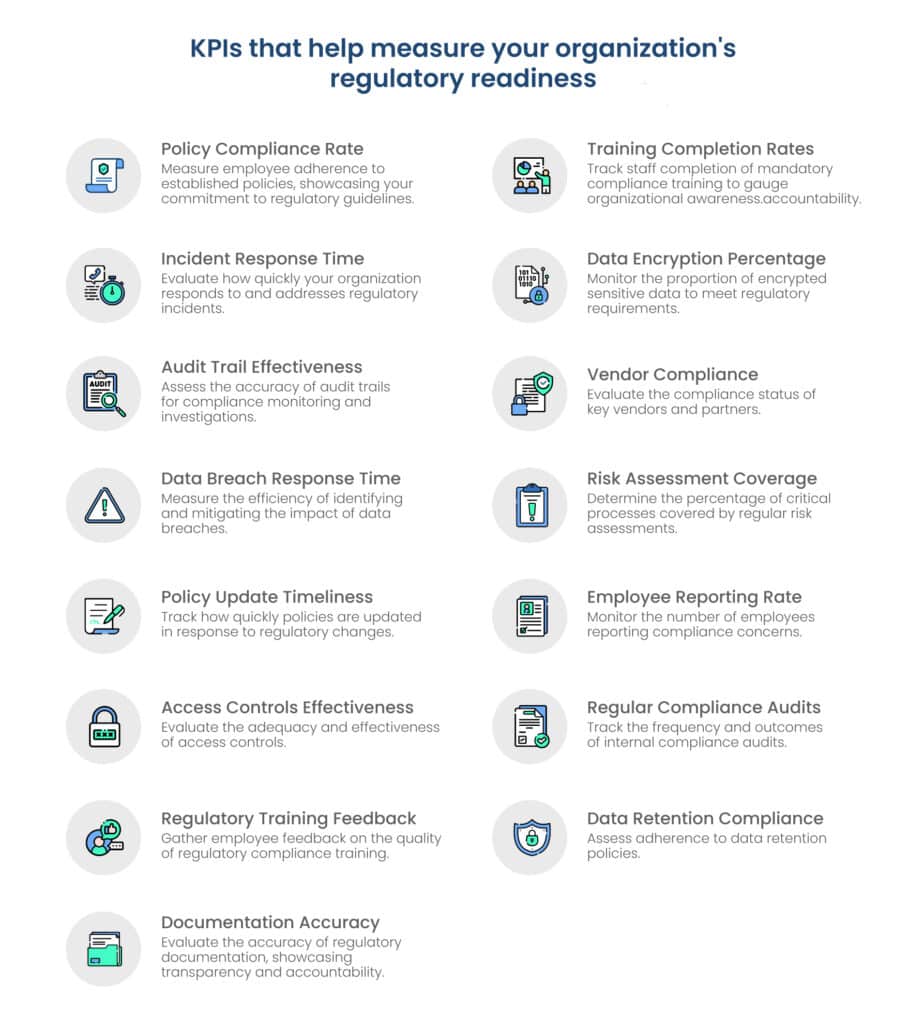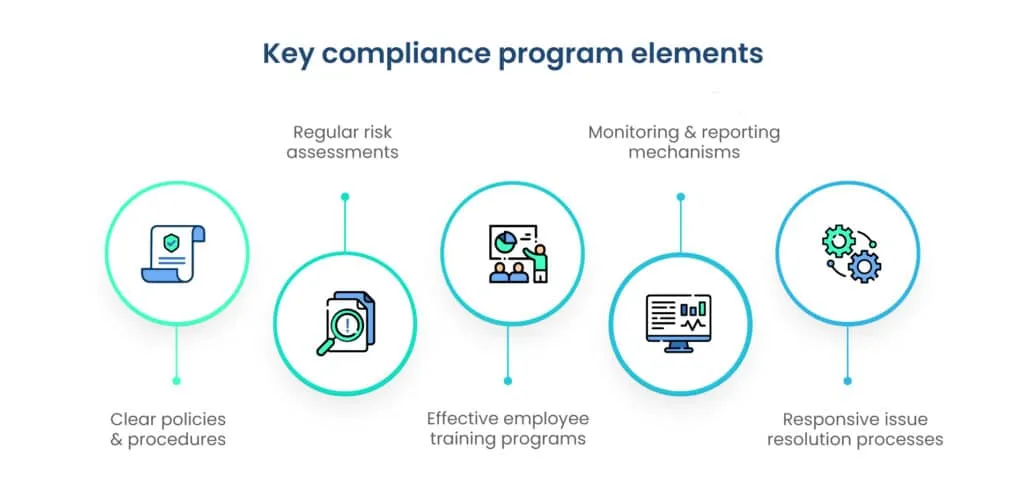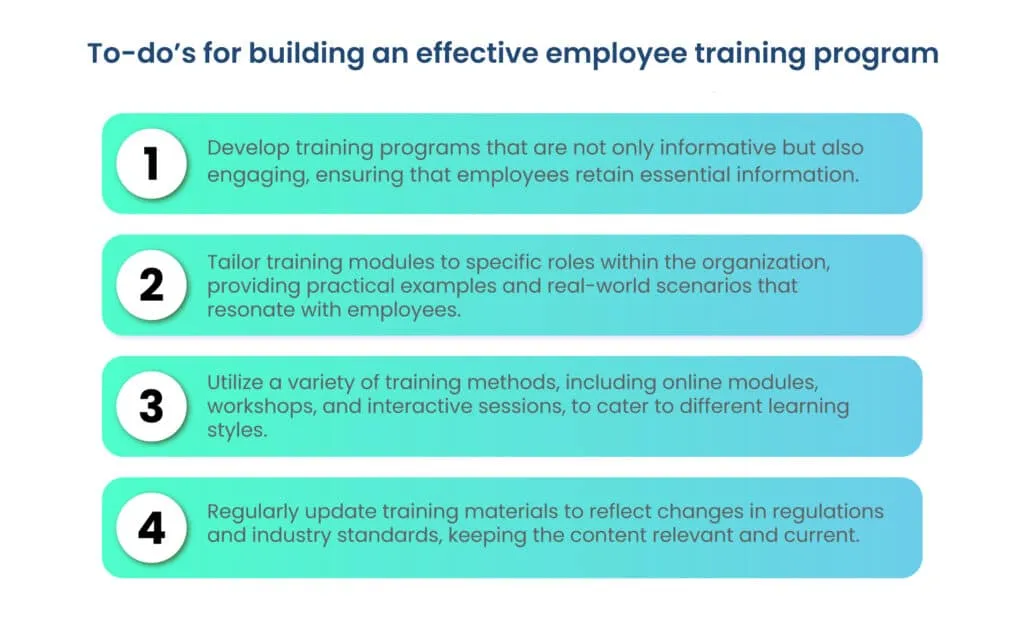Elevating the operating effectiveness of your compliance program

In the dynamic landscape of business operations, compliance programs serve as the bedrock for organizational integrity, risk mitigation, and sustainable success.
Today, organizations face a growing challenge: ensuring the effectiveness of their compliance programs. As regulations evolve and become more intricate, businesses are under constant pressure to adapt and mitigate risks. The lack of a robust compliance framework can expose companies to legal consequences, financial setbacks, and damage to their reputation.
Discovering the path to a solution begins with understanding the pivotal role that operating effectiveness plays in the success of a compliance program. By acknowledging the challenges and recognizing the importance of a well-executed compliance strategy, organizations can proactively address issues.
Join us as we navigate the road to a more effective and resilient compliance program.
What is a compliance program?
A compliance program is a systematic and strategic framework implemented by organizations to ensure adherence to relevant laws, regulations, policies, and ethical standards governing their industry. Its primary goal is to mitigate legal and financial risks by promoting a culture of integrity, transparency, and ethical conduct within the organization.
A well-structured compliance program typically includes clearly defined policies and procedures, comprehensive risk assessments, regular employee training, monitoring mechanisms, and a responsive system for addressing issues.
For instance, a healthcare compliance program is essential in the medical industry, encompassing policies, training, and monitoring to ensure adherence to strict regulatory standards, protect patient privacy, and uphold ethical practices in healthcare delivery.
By fostering a commitment to compliance at all levels of the organization, compliance programs aim to safeguard against legal violations, protect the organization’s reputation, and contribute to the overall sustainability and success of the business in a complex and ever-evolving regulatory landscape.
Assessing current compliance effectiveness
Here is how to delve into the pivotal process of evaluating and enhancing the current effectiveness of your compliance program.

Conduct a comprehensive internal audit
Conducting a thorough internal audit is the cornerstone of assessing and enhancing the effectiveness of your compliance program.
- Step 1: Begin by establishing a detailed audit plan that outlines the scope, objectives, and methodologies. This plan should encompass a review of existing policies and procedures, an evaluation of their implementation across different departments, and an examination of data integrity and accuracy.
- Step 2: Utilize both internal and external resources, leveraging the expertise of compliance professionals and engaging independent auditors if necessary.
- Step 3: Interviews with key personnel, document reviews, and on-site assessments can provide valuable insights into the day-to-day operations of your compliance program.
- Step 4: Regularly update the audit process to stay aligned with evolving regulatory requirements.
Use Key Performance Indicators (KPIs) to measure compliance effectiveness

Identifying and tracking key performance indicators (KPIs) is essential for quantifying the success of your compliance program.
- Establish KPIs that align with your organization’s goals and regulatory requirements. Some critical KPIs include the timeliness of incident reporting and resolution, the percentage of employees completing mandatory training, and the accuracy of compliance documentation.
- Regularly analyze and interpret KPI data to gain actionable insights into the strengths and weaknesses of your compliance efforts. These metrics not only provide a snapshot of current performance but also serve as benchmarks for continuous improvement.
Gather feedback from stakeholders for a holistic assessment
Engaging with stakeholders is a vital component of a holistic assessment. Below are a couple of methods to do so.
- Solicit feedback from employees at all levels, as well as legal and compliance experts, to capture diverse perspectives on the effectiveness of your compliance program.
- Anonymous surveys, focus group discussions, and one-on-one interviews are effective tools for gathering candid insights.
- Consider external stakeholders such as customers, suppliers, and regulatory authorities to ensure a comprehensive evaluation. This feedback not only reveals potential blind spots in your program but also fosters a culture of transparency and collaboration.
- Act on constructive feedback to address specific concerns and continuously refine your compliance approach.
Components of a high-performing compliance program
Key compliance program elements encompass a multifaceted approach designed to ensure adherence to legal and regulatory requirements.

Together, these elements form a comprehensive framework that promotes ethical behavior, minimizes risks, and upholds the integrity and reputation of the organization in an ever-changing regulatory landscape.
1. Clear policies and procedures
At the core of a high-performing compliance program are clear and well-documented policies and procedures. These documents serve as the foundation, outlining the ethical standards and guidelines that employees must adhere to.
Policies should be easily accessible, written in a language understandable to all employees, and regularly updated to reflect changes in regulations. Clear communication of expectations fosters a shared understanding of compliance requirements throughout the organization.
2. Regular risk assessments
Effective risk management is integral to a high-performing compliance program. Regularly conducting comprehensive risk assessments allows organizations to identify, evaluate, and prioritize potential risks that could impact compliance.
This proactive approach enables the allocation of resources to areas of higher risk and informs the development of targeted mitigation strategies.
Risk assessments should consider changes in the regulatory landscape, industry trends, and internal operational factors, ensuring that the compliance program remains adaptive and resilient.
3. Effective employee training programs
A cornerstone of compliance success is investing in comprehensive and ongoing employee training programs. These initiatives educate employees about the organization’s policies, relevant regulations, and the importance of ethical conduct.
Training should be tailored to specific roles and responsibilities, offering practical scenarios and real-world examples. Regular training sessions not only keep employees informed about compliance requirements but also cultivate a culture of awareness, responsibility, and ethical behavior throughout the organization.
Establishing this culture starts with leadership exemplifying and championing compliance values, setting the tone for the entire workforce.

Heightened employee awareness is a powerful tool in minimizing non-compliance risks. Well-informed employees, versed in compliance policies and potential consequences, make informed decisions, acting as a preventive measure against inadvertent violations.
This heightened awareness encourages proactive issue reporting, fostering a culture of transparency and accountability. The impact extends beyond individual behaviors, significantly contributing to the organization’s overall risk mitigation efforts.
Scrut simplifies employee compliance training by seamlessly integrating it into the platform. This in-platform training feature eliminates the need for external modules, providing a hassle-free experience.
Employees can access training materials, policy updates, and resources within Scrut, streamlining the learning process and promoting a culture of continuous education. This integrated approach enhances user engagement and awareness, contributing to a more informed and compliant workforce.
4. Monitoring and reporting mechanisms
High-performing compliance programs incorporate robust monitoring and reporting mechanisms to track adherence to policies and detect potential issues in real time.
Utilizing technology, such as compliance management software, allows for continuous monitoring of key performance indicators and prompt identification of deviations.
Reporting mechanisms should encourage open communication, enabling employees to report concerns without fear of retaliation. Regularly reviewing and analyzing monitoring data ensures that the organization remains proactive in addressing emerging compliance challenges.
5. Responsive issue resolution processes
No compliance program is foolproof, making responsive issue resolution processes critical for maintaining effectiveness. Establishing a clear and expedient system for addressing identified issues fosters a culture of accountability and continuous improvement.
The issue resolution process should include thorough investigations, appropriate corrective actions, and preventive measures to mitigate the risk of recurrence.
Transparent communication about the resolution process instills confidence among employees and stakeholders, reinforcing the organization’s commitment to ethical conduct and compliance excellence.
Explore Scrut’s MetaData enrichment feature in Scrut’s remediation guide, an innovative remediation feature for cloud security. It empowers organizations with swift and independent security without external dependencies.
Focusing on security, the feature provides additional context and metadata for all 300+ controls on the platform. Every finding is intricately linked to the right controls, guiding you precisely on addressing and securing failing controls.
This feature revolutionizes the remediation of cloud misconfigurations, eliminating manual intervention for vanilla findings and offering supporting information for accelerated remediation.
Scaling operative effectiveness with Scrut
Organizations are increasingly turning to technology to enhance the efficiency and effectiveness of their compliance programs.
Compliance management software provides a centralized platform for organizing, implementing, and monitoring compliance efforts. These tools often include features such as policy management, training tracking, and incident reporting.
By offering a comprehensive overview of the entire compliance landscape, these platforms empower organizations to proactively manage and adapt to regulatory changes.
Here are three pivotal features that set Scrut apart:
1. Automation
Scrut’s automation capabilities revolutionize compliance management. By automating routine tasks, organizations can significantly enhance operational efficiency and reduce the likelihood of human error.
From data collection to report generation, Scrut’s automation streamlines processes, allowing teams to focus on strategic aspects of compliance rather than getting bogged down by repetitive tasks.
2. Collaboration with compliance experts
In the realm of compliance, collaboration is key. Scrut facilitates seamless collaboration between internal teams and compliance experts. Whether it’s sharing insights, seeking guidance, or conducting virtual compliance audits, Scrut’s collaborative features empower organizations to leverage collective expertise. This collaborative approach ensures a holistic and well-informed compliance strategy.
3. Policy and procedure adjustments with AI
Scrut incorporates an advanced AI model that adapts to the evolving regulatory landscape. This model not only interprets compliance requirements but also suggests policy and procedure adjustments based on the latest industry standards.
Organizations can stay ahead of the compliance curve with Scrut’s proactive AI, making adjustments swiftly and effectively to align with changing regulations.
In essence, Scrut goes beyond being a compliance tool; it’s a strategic ally in scaling operational effectiveness. Through automation, collaboration, and AI-driven policy adjustments, Scrut empowers organizations to navigate the complexities of compliance with agility and foresight.
Wrapping up
In the ever-evolving environment of regulatory requirements, the journey to improve the operating effectiveness of your compliance program is both a strategic imperative and a continuous pursuit of excellence.
From assessing the current landscape to integrating technology, adapting to regulatory changes, and fostering a compliance-conscious culture, each component plays a crucial role in fortifying your organization against risks and promoting ethical conduct.
A robust compliance program is not a one-size-fits-all solution but a dynamic framework that requires ongoing attention and adaptation. Scrut can help you stay informed, leverage technology, and prioritize employee training and awareness to help your organization navigate the complexities of compliance and position itself as an ethical leader in your industry. Get in touch to learn more!
Frequently Asked Questions
1. How can I assess the current operating effectiveness of my compliance program?
Conduct a comprehensive audit, assess internal processes, and gather feedback from stakeholders. Key performance indicators (KPIs) such as timely reporting, incident resolution, and policy adherence can provide valuable insights.
2. What are the key components that contribute to a high-performing compliance program?
A robust compliance program includes clear policies, regular risk assessments, effective training, strong monitoring and reporting mechanisms, and a responsive system for addressing issues promptly.
3. Are there specific technologies or tools that can streamline compliance operations effectively?
Yes, compliance management software, data analytics tools, and automation technologies can significantly streamline compliance processes. These tools help with data analysis, monitoring, reporting, and ensuring real-time compliance updates.
4. How can organizations adapt their compliance programs to evolving regulatory requirements?
Stay informed about regulatory changes through continuous monitoring. Establish a flexible framework that allows for prompt updates to policies and procedures. Regularly engage with legal and compliance experts to interpret and implement changes effectively.
5. What role does employee training and awareness play in improving compliance program effectiveness?
Employee training is crucial for creating a compliance-conscious culture. Regular training sessions ensure employees understand policies, procedures, and the importance of compliance. Increased awareness reduces the likelihood of non-compliance and strengthens the overall effectiveness of the program.


















